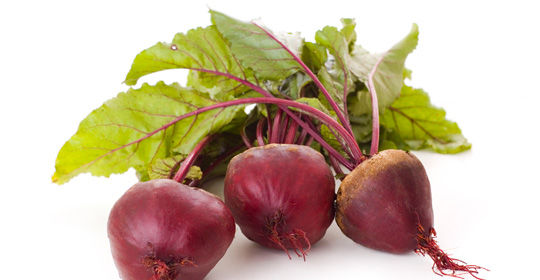
By Natalie Digate Muth, M.D., M.P.H., R.D.
A group of U.K. researchers may have just tapped into the next big all-natural, performance-enhancing . . . vegetable? A research team led by Dr. Katherine Lansley and Dr. Andrew Jones at the University of Exeter has been conducting a series of experiments looking at the impact of beetroot juice on exercise performance. The results are impressive.
What's in a Beet?
Beetroot juice is the blended up, liquefied version of the beet. While the taste might take a little getting used to [for best results, most raw-food connoisseurs recommend a 4:1 dilution with the juice of other (preferably sweeter) vegetables and fruits], the juice from this vegetable is packed with a nutritional punch and a long list of health benefits including increased performance, decreased blood pressure and overall improved cardiovascular health (Lundberg et al., 2011). (Don’t be alarmed if, after eating beets or drinking beetroot juice, your urine turns pink.)
Nutrient
|
100g of raw beet
(approx. 1–2” diameter beet
or 4 oz. of juice) |
| Calories |
43 |
|
Carbohydrate
|
10 g |
| Sugars |
7 g |
| Dietary fiber |
3 g |
| Protein |
2 g |
|
Fat
|
0 g |
| Potassium |
325 mg (7%)
|
| Folate |
27% |
|
Vitamin B6
|
5% |
| Vitamin C |
6% |
| Iron |
0.8 mg (6%) |
| Magnesium |
23 mg (6%) |
|
Phosphorus
|
40 mg (6%) |
Source: USDA Nutrient Database
In one study, researchers gave a group of competitive male cyclists either 16 ounces of beetroot juice or 16 ounces of a nitrate-free placebo beetroot juice about 2.5 hours before completing a 4 kilometer (2.5 miles) or a 16.1 kilometer (10 miles) timed trial. Two to three days later, each athlete completed the workout again, this time with a different drink–distance combination. In all, each of the athletes completed four trials with two to three days separating the workouts. Once the times were tallied, the researchers found that beetroot juice improved trial time by about 2 percent to 3 percent in both the short- (lasting about five minutes) and longer-distance (lasting about 30 minutes) trials when compared to the nitrate-free placebo (Lansley et al., 2011a).
The authors credit the nitrate in beetroot juice for the improved performance. The thinking is that the body converts inorganic nitrate (found in high levels in beets as well as most green leafy vegetables) into bioactive nitrite. (Blood nitrite levels more than doubled in the beetroot juice group compared to the placebo group in the study of cyclists.) The body converts the nitrite to nitric oxide, which is known to improve vasodilation and blood flow in vessels. This could provide a mechanism for decreased oxygen cost of exercise and thus increased athletic performance.
This research team also looked at the effects of beetroot juice on blood pressure; mitochondrial oxidative capacity, a marker of how efficiently and effectively the body converts food to fuel; and physiological responses such as how much oxygen is required to fuel walking and moderate- to high-intensity running and how long a participant could exercise before exhaustion. They found that participants who consumed the beetroot juice had lower blood pressures and experienced a lower oxygen cost of exercise. In fact, walkers had a significant 12 percent to 14 percent decrease in the amount of oxygen needed. The authors point out that this could have significant implications for improving exercise capacity in people who suffer from certain cardiovascular and pulmonary diseases. The participants also had decreased overall maximal oxygen consumption (VO2max), but this was compensated for with an increased time to exhaustion (Lansley et al., 2011b).
While these studies have several limitations, including small sample size (only nine participants) and gender bias (no females were studied), the results are promising. While one can’t say with certainty that loading up on beets will set your clients up for a new personal best, the potential benefits seem to outweigh any known risks. Instead of passing by the crimson vegetable (and its green leafy cousins) at the grocery store, consider giving the nitrate-packed veggie and its juice a fresh try.
References
Lansley, K.E. et al. (2011a) Acute dietary nitrate supplementation improves cycling time trial performance. Medicine & Science in Sports & Exercise, 43, 6, 1125–1131.
Lansley, K.E. et al. (2011b) Dietary nitrate supplementation reduces the O2 cost of walking and running: a placebo-controlled study. Journal of Applied Physiology, 110, 3, 591–600.
Lundberg, J.O. et al. (2011). Roles of dietary inorganic nitrate in cardiovascular health and disease. Cardiovascular Research, 89, 3, 525–532.
_________________________________________________________________________

Natalie Digate Muth, M.D., M.P.H., R.D., is a pediatrics resident at UCLA Medical Center, a registered dietitian and a spokesperson for the American Council on Exercise (ACE). She holds fitness certifications from ACE, the American College of Sports Medicine and the National Strength and Conditioning Association. She’s also mom to two young children, Tommy (3) and Mariella (11 months).